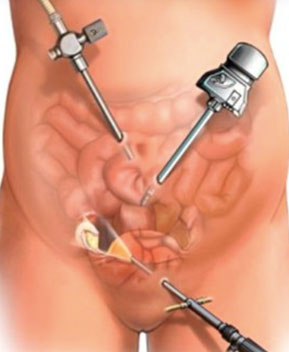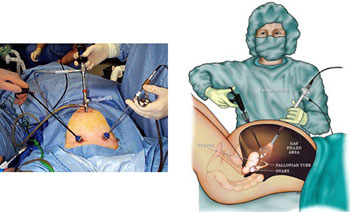Laparoscopic Cystectomy (surgery to remove ovarian cysts)
Laparoscopic cystectomy is the removal of ovarian cysts or masses using laparoscopy. Ovarian cysts are removed using the laparoscopic technique. During laparoscopy, a camera is inserted into the patient's abdomen through small incisions. Then the cyst in question is removed through 3-4 incisions of 1-2 cm. Generally, patients’ cysts in the ovaries that persist, grow or cause discomfort are operated on. The advantage of laparoscopy is that the procedure can be performed with minimal damage to the patient’s ovary.

Which cysts can be operated on laparoscopically?
This is decided by taking into account the patient’s age, general health, the contents and size of the cyst, and the patient's symptoms. In general, cysts larger than 7 cm that grow, do not regress, and cause the patient severe discomfort and pain are surgically removed.
Laparoscopic cystectomy can be performed in patients of any age. However, for very large cysts and for cysts where cancer is suspected, open classical surgery may be recommended.

What can be expected with laparoscopic cystectomy?
Laparoscopy is usually performed under general anesthesia. After the surgeon makes a small incision in the patient's abdomen, the abdomen is inflated with carbon dioxide gas. This allows all internal organs to be clearly seen. Then 2-3 more small incisions are made and the cyst is examined. During all these procedures, care is taken to minimize damage to the patient's ovaries and fallopian tubes. Sometimes the patient's ovaries, fallopian tubes and cysts are heavily fused with surrounding organs, making surgery difficult. In some cases, the cyst bursts during the procedure. However, this is usually not a problem. After the cyst is removed, the tiny incisions in the abdomen are sutured, and the patient is awakened. In the postoperative period, the patient can go home the same day or the next day. However, recovery time varies from patient to patient. Yet, most women can start work and light activities after 2 weeks at the earliest.
What are the risks associated with laparoscopic cystectomy?
Laparoscopic cystectomy is a relatively safe procedure. However, like all surgeries, it carries some potential risks. Each patient is given a detailed explanation of the potential complications and risks before surgery.
- Ovarian cysts and chocolate cysts can recur
- Risks associated with anesthesia
- Infection
- Hematoma (blood suffusion)
- Allergic reactions
- Damage to the nerves
- Clots in the lungs
- Damage to and subsequent removal of ovaries and fallopian tubes
- Damage to internal organs
In particular, these risks are somewhat higher in patients who have already had abdominal surgery, have adhesions in the abdomen, or are overweight.

What can be expected in the postoperative period?
Slight pain and bruising after surgery, especially in the abdomen, is normal. Because we inject gas into the abdomen, pain in the shoulders and back can also be expected on the first day after surgery. You may also have vaginal discharge or spotting. You will have bandages on your abdomen. Even if these are not removed, they will fall off on their own. Ask your health care provider if these dressings will fall off. Do not get your stitches wet by swimming or bathing. You can take a shower, but do not rub the wound sites.
A week after surgery, you may feel more tired than usual. Relax during this first week and do not get tired. It is a good idea to take a walk and gradually increase it. When you feel well and the wound has healed, you can have sexual intercourse.
If you notice any of the following symptoms, you should go to the nearest emergency room and inform your doctor.
- High fever
- Nausea and vomiting
- Excessive bleeding
- Redness, discharge at the wound sites





